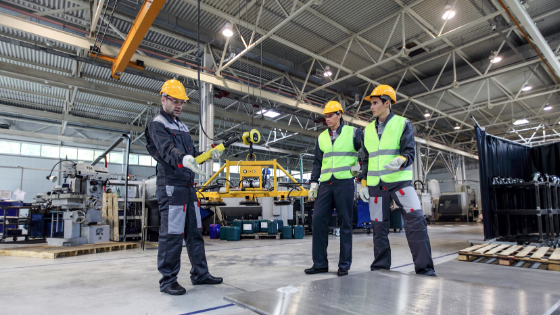GENERAL
Building a Strong Safety Culture: A Comprehensive Guide

Building a strong safety culture requires commitment from all levels of an organization, starting with leadership. It involves clear communication about safety policies, continuous training, and fostering an environment where employees feel empowered to report hazards. Setting measurable safety goals and recognizing safe behaviors can encourage active participation. Regular safety audits and reviews help identify risks, and addressing them promptly demonstrates accountability. A collaborative approach ensures that safety becomes ingrained in everyday operations, reducing accidents and promoting a healthy, secure work environment for all employees.
Introduction
Creating a strong safety culture is paramount for any organization aiming to protect its employees and ensure a productive work environment. A proactive safety culture in the workplace minimizes accidents and injuries and enhances morale, productivity, and job satisfaction. This culture reflects shared values and practices emphasizing prevention rather than reaction, integrating safety into all areas of the organization’s operations and making it a core priority. This article will cover in-depth tactics and advice on creating a strong workplace safety culture.
The Importance of Safety Culture
Safety culture refers to the shared beliefs, practices, and mindsets that determine how an organization approaches safety. An influential safety culture prioritizes safety management systems, continuous learning, and proactive measures to prevent accidents before they occur. This proactive attitude is crucial as it signifies a shift from merely complying with safety regulations to embedding safety as a core value within the organization. Research has shown that companies with strong safety cultures experience fewer workplace accidents, lower staff turnover, and higher levels of job satisfaction. Furthermore, a robust safety culture can enhance an organization’s reputation and reduce legal and financial liabilities.
Actionable Strategies to Foster a Safety Culture
Leadership Commitment
Establishing a safety culture requires strong leadership. When management visibly prioritizes safety, employees are more likely to follow suit. This means allocating resources, setting clear safety expectations, and leading by example. By starting safety campaigns, attending safety training sessions, and often bringing up safety issues at meetings, leaders may show their dedication to the cause. To further emphasize their commitment, leaders should celebrate safety milestones and recognize employees contributing to a safer workplace. This visible and active involvement from leadership sets a precedent and builds trust among employees, showing that safety is a priority from the top down.
Comprehensive Training Programs
Training regimens that are comprehensive and consistent are crucial. Workers need to know the ins and outs of safety practices. Incorporating hands-on training, interactive modules, and periodic refreshers ensures that information remains fresh and top of mind. Effective training programs are tailored to different organizational roles’ specific needs and risks. For instance, new employees might require a comprehensive onboarding program, while experienced staff benefit from advanced or specialized training sessions. Supplemental resources such as safety bulletins, instructional videos, and safety drills can reinforce the training. Employers may maintain a high level of worker readiness and safety awareness by making training a continuous process instead of a one-time occurrence.
Open Communication Channels
Encourage open communication about safety concerns and suggestions. Establishing anonymous reporting systems can help employees feel safer voicing potential hazards. CDC’s guide on safety culture emphasizes the importance of fostering an environment where everyone feels responsible for safety. Regular safety meetings and suggestion boxes are practical tools for gathering feedback and encouraging dialogue. Moreover, promptly addressing reported concerns and providing input on implemented changes reinforces the idea that employees’ voices matter. This culture of openness helps identify and mitigate risks and enhances cooperation and trust throughout the organization.
Real-Life Examples of Successful Safety Initiatives
Many companies have successfully implemented safety culture initiatives. For example, a manufacturing firm reduced workplace accidents by introducing a peer-review safety program. This program empowered employees to conduct safety audits, identify potential hazards, and recommend improvements, fostering a sense of ownership and accountability. Similarly, a healthcare organization saw improved employee health by launching a wellness program focused on ergonomics and mental health support. With the help of this comprehensive approach, which addressed physical and psychological health, the workforce became more resilient and engaged. Another notable example is a construction company that introduced a safety incentive program, rewarding teams for maintaining accident-free records, which instilled a competitive spirit and heightened safety awareness.
Continuous Improvement Through Data and Feedback
Gathering data and feedback is crucial for continuous improvement. Regularly review accident reports, conduct safety audits, and utilize employee surveys to gather insights. Use this data to refine existing safety practices and develop new ones, ensuring your safety culture evolves with changing needs. Implementing a robust incident tracking system can help identify trends and root causes while comparing data across departments and highlighting areas needing attention. Engaging with external safety consultants can provide fresh perspectives and innovative solutions. Organizations may maintain a dynamic and successful safety program and remain ahead of new hazards by cultivating a learning and continuous improvement culture.
Conclusion
Incorporating these strategies can significantly enhance your workplace safety culture. From leadership commitment to continual development, every element is required to build a safe and effective work environment. By prioritizing safety, you empower employees and build a foundation for long-term success. Remember, a strong safety culture is an ongoing journey that requires dedication and adaptability. With persistent effort and a proactive attitude, you can create an atmosphere where safety is engrained in every activity and decision, eventually resulting in a happier, healthier, and more productive workforce.
GENERAL
Efficient Water Transport for Demanding Industries

Water is a critical resource across a vast array of industries, from agriculture and mining to food and chemical processing. Its efficient transport, however, remains a logistical challenge, particularly in operations where reliability, hygiene, and safety are non-negotiable. For sectors reliant on large-scale water handling, adopting the right transport systems is not just about convenience; it’s a pivotal part of operational continuity and compliance.
In this article, we explore the core considerations for efficient water transport in high-demand environments and how choosing the right equipment can significantly reduce risk, waste, and downtime.
Understanding the Unique Demands of Industrial Water Transport
Unlike domestic or small-scale water handling, industrial water transport must contend with remote locations, rough terrain, and exposure to harsh chemicals or extreme temperatures. Additionally, many sectors—such as agriculture or chemical manufacturing—depend on water for direct production processes, making it essential that water be transported quickly and without contamination.
Water cartage in these industries typically involves movement from central water sources (bores, dams, treatment plants) to operational sites, often over significant distances. The water being transported may serve purposes as diverse as irrigation, cleaning, dust suppression, or even as an ingredient in food and beverage manufacturing. In each case, container integrity and transport efficiency are vital.
Key Features of Effective Water Transport Solutions
Choosing the right transport solution means evaluating a range of factors that affect durability, efficiency, and safety. These include:
1. Material Composition
The material used in water transport tanks plays a major role in performance and longevity. Polyethylene (plastic) tanks are lightweight, corrosion-resistant, and ideal for many agricultural and industrial settings. Stainless steel tanks, on the other hand, offer enhanced resistance to extreme temperatures and chemical exposure, making them suitable for more volatile environments like chemical or mining sectors.
2. Capacity and Design
Industrial operations often require large water volumes to be moved in fewer trips. Therefore, tank size and shape must be optimised for both capacity and stability during transport. Tanks must be designed to reduce sloshing (the uncontrolled movement of liquid) to maintain vehicle balance and ensure safety, especially when navigating uneven terrain.
3. UV and Chemical Resistance
In outdoor or chemical-heavy environments, exposure to UV rays and corrosive substances can compromise tank integrity over time. High-quality tanks should include UV-stabilised and chemical-resistant properties to prevent cracking, fading, or contamination.
4. Compatibility with Transport Systems
Water transport tanks need to be compatible with the vehicles they’re mounted on, whether that be trailers, trucks, or utes. Features like moulded mounting points, integrated baffles, and secure strapping systems help reduce installation time and improve operational safety.
5. Compliance and Safety Standards
Meeting industry regulations for environmental protection and occupational health is non-negotiable. Tanks should be compliant with AS/NZS standards, particularly when dealing with potable water or hazardous environments. Optional add-ons such as spill containment bunds can also help manage risk in sensitive sites.
Selecting the Right Tank for Your Industry
With so many operational variables in play—from location and climate to chemical exposure and delivery volumes—the process of selecting the right tank should always begin with a clear understanding of industry-specific needs. For example, a winemaker may prioritise hygiene and odour control, while a mining operator may need high durability and resistance to vibration or pressure.
In either case, the solution should be designed with resilience and adaptability in mind. This is where investing in durable and reliable water cartage tanks becomes a strategic advantage, offering long service life and consistent performance even under demanding conditions.
Moving Forward with Greater Efficiency
Efficient water transport is not simply about moving liquid from A to B—it’s about doing so safely, sustainably, and without disruption to your operations. With evolving compliance requirements, increasingly remote work environments, and a growing emphasis on sustainability, now is the time for industries to reassess their transport solutions.
By selecting tanks that meet the highest standards of design and performance, businesses can avoid costly downtime, reduce waste, and future-proof their water logistics for years to come.
GENERAL
Dr Doom: From Latverian Scholar to Supreme Sovereign

When dr doom first emerged in Fantastic Four #5 (July 1962), few could have predicted that Victor Von Doom would become one of Marvel’s most enduring antagonists. Driven by a blend of scientific brilliance and mystical prowess, dr dooms has challenged heroes and reshaped entire realities. This article delves into the unique facets of dr dooms character, his evolution over six decades, and the reasons he remains a touchstone in comic-book storytelling.
The Origin of dr doom
Early Years of dr dooms
Victor Von Doom was born into hardship in the small nation of Latveria. Orphaned by a tragic accident and raised among Romani travelers, young Victor displayed a prodigious intellect. Determined to overcome his impoverished roots, he vowed to master both technology and magic. The crucible of his youth forged a resilient spirit, setting the stage for dr doom’s eventual rise to power and his lifelong vendetta against anyone who underestimated him.
The Fateful Accident
While studying at Empire State University, Victor’s ambition outpaced his caution. Attempting to contact the spirit world, he bypassed critical safety protocols and suffered severe facial burns. His disfigurement became both a symbol of his hubris and a catalyst for adopting the iron mask. From that moment on, dr dooms cloaked his true face—and his deepest vulnerabilities—behind an impenetrable suit of armor.
dr dooms Extraordinary Abilities
Scientific Genius of dr doom
No mind in the Marvel Universe rivals dr dooms grasp of physics, robotics, and cybernetics. He has engineered time machines, energy weapons, and artificial intelligences capable of challenging even Tony Stark’s creations. His inventions frequently push the boundaries of contemporary science, blending cutting-edge engineering with theoretical breakthroughs.
Mystical Mastery of dr dooms
Beyond his technological exploits, dr doom became an adept sorcerer, studying arcane texts and allying with supernatural entities. He has wielded eldritch energies to combat celestial threats and thwart otherworldly invaders. This rare fusion of magic and machinery places dr dooms in a category all his own—part scientist, part sorcerer, fully formidable.
dr doom’s Complex Relationships
Rivalry with Reed Richards
At the heart of dr doom’s story is his enduring conflict with Reed Richards (Mr. Fantastic). Their intellectual rivalry began in university and intensified after the accident that scarred Doom’s face. Doom blames Richards for his disfigurement, even though Victor’s own arrogance precipitated the disaster. Their clashes blend personal animosity with philosophical debate over the proper use of power.
Alliances and Antagonists of dr dooms
Although often depicted as a solitary ruler, dr doom has formed uneasy alliances when his goals align with other heroes or villains. He has cooperated with the Avengers, the X-Men, and even occasionally aided the Fantastic Four—provided his vision for Latveria remains unchallenged. Conversely, Doom has battled foes like Doctor Strange, the Silver Surfer, and Thanos, proving that his ambitions know no bounds.
Iconic Storylines Featuring dr doom
Secret Wars: God Emperor dr doom
In the 2015 Secret Wars event, dr dooms ascends to godhood by seizing the power of the Beyonders. Reborn as “God Emperor Doom,” he reshapes reality itself, testing the limits of what any individual can achieve. This narrative demonstrates the full extent of his ambition—and the peril of absolute authority.
Books of Doom: Unmasking dr doom
Books of Doom (2006) peels back the mask to reveal Victor’s tragic past and the motivations that drive him. It humanizes dr doom, showing a man torn between altruism and ego. By exploring his childhood, mentors, and early failures, this miniseries adds layers of empathy to an otherwise fearsome figure.
Infamous Iron Man: Redemption of dr dooms
After Tony Stark’s apparent demise, dr doom assumes the mantle of Iron Man in 2016’s Infamous Iron Man. Presenting himself as a reformed hero, he seeks to atone for past sins. While some view this as a genuine quest for redemption, others suspect another of Doom’s elaborate schemes. The arc leaves readers questioning whether true change is possible for someone like dr dooms.
dr dooms in Modern Media
Animated Appearances of dr doom
From Spider-Man and His Amazing Friends to Avengers: Earth’s Mightiest Heroes, dr doom has appeared in numerous animated series. Each adaptation emphasizes different traits—sometimes highlighting his regal bearing, other times focusing on his mystical side.
Film and Video Game Portrayals
Live-action films (Fantastic Four 2005, 2015) and video games (Marvel Ultimate Alliance, Marvel vs. Capcom) have introduced dr dooms to wider audiences. While critics often debate the fidelity of these portrayals, they underscore Doom’s status as a marquee villain in transmedia storytelling.
The Enduring Appeal of dr dooms
Philosophical Depth of dr doom
Unlike many one-dimensional adversaries, dr doom operates according to a personal code of honor. He genuinely believes that only he has the vision to lead humanity toward order and prosperity. This blend of megalomania and idealism transforms him into a character readers can both despise and strangely respect.
Legacy and Influence of dr doom
For over sixty years, dr dooms has inspired countless writers, artists, and fans. His distinctive armor and regal posture influenced designs in video games, tabletop role‑playing, and even fashion. The name “Doom” itself has become shorthand for an unstoppable force—an echo of Victor Von Doom’s lasting impact.
Conclusion: The Unmasking of dr doom
Through triumphs and defeats, dr doom remains an icon of ambition, intellect, and mysticism. His journey from a scarred scholar to a would‑be god illustrates the dual edges of power. As Marvel continues to explore multiverse stories and new cinematic ventures, one thing is certain: dr dooms iron mask will never rust in the annals of comic-book lore.
GENERAL
Sophie Rain: Charting an Authentic Path

When you come across the name Sophie Rain, you might first think of striking images on social media or thought‑provoking content that lingers long after you scroll away. From her earliest experiments with storytelling to her current role as a purpose‑driven creator, Sophie Rains embodies a blend of authenticity and innovation. In this detailed exploration, we’ll journey through her background, creative strategies, community influence, and the values that set her apart.
Introduction to Sophie Rain’s World
Long before algorithms and analytics, Sophie Rains nurtured a passion for creative expression. As a young observer of the world around her, she sketched scenes, wrote journal entries, and captured fleeting moments on camera. This innate curiosity laid the groundwork for a career defined by sincerity and artistry.
The Early Days of Sophie Rain
Raised in a supportive environment, Sophie Rain’s childhood revolved around art and empathy. Family vacations doubled as photo adventures, and weekend afternoons often transformed into impromptu writing workshops. By high school, she was seamlessly blending visual storytelling with reflective essays—an approach that hinted at her future digital storytelling prowess.
Sophie Rains Digital Breakthrough
The first time Sophie Rain shared her work online, it was through a simple blog post. What followed was a gradual but steady wave of engagement. Audiences resonated with her candid reflections, aesthetic photographs, and carefully crafted narratives. Rather than chasing trends, she honed her voice, ensuring every post reflected her genuine perspective.
Key Traits That Define Sophie Rain
1. Authenticity Above All
At the core of Sophie Rains brand lies unwavering authenticity. Whether she’s discussing personal growth, mental health, or creative projects, her honest tone fosters deep connections. Followers know they’re engaging with a real person rather than a polished persona.
2. Versatile Creativity
From studio photography and short films to written essays and live streams, Sophie Rains refuses to be confined by a single medium. This versatility not only showcases her talent but also keeps her audience eagerly anticipating each new release.
Building Community with Sophie Rains
An engaged community surrounds Sophie Rain. By encouraging open discussions, hosting Q&A sessions, and spotlighting diverse voices, she creates a safe space for followers to share experiences and learn from one another. Her comment sections often read like collaborative brainstorming sessions, reflecting a genuine two‑way dialogue.
The Business Acumen of Sophie Rain
Behind every creative endeavor, Sophie Rains applies strategic thinking. She’s launched limited‑edition merchandise, designed online workshops, and partnered with purpose‑aligned brands. Each venture reflects her commitment to sustaining creativity without compromising core values.
Sophie Rain’s Social Impact Initiatives
Driven by compassion, Sophie Rains leverages her platform for causes she believes in. Mental health awareness, environmental stewardship, and inclusive representation top her agenda. Campaigns featuring actionable steps—like mindful consumption or peer support—underscore her belief that influence carries responsibility.
Overcoming Challenges: The Sophie Rains Way
No journey is without setbacks. Sophie Rain has navigated declining engagement, creative blocks, and the pressures of digital comparison. Through transparent reflections and intentional self‑care routines, she models resilience, reminding others that growth often follows adversity.
Looking Ahead: The Future of Sophie Rain
As she plots her next chapter, Sophie Rains hints at ventures into long‑form storytelling and collaborative multimedia projects. A forthcoming digital magazine and a series of community workshops signal her ongoing dedication to elevating underrepresented voices and nurturing emerging talent.
Conclusion: Embracing the Sophie Rain Spirit
Sophie Rain’s story illustrates how authenticity, creativity, and purpose can coalesce into a powerful personal brand. In an era dominated by ephemeral content, her thoughtful approach offers lasting inspiration. Whether you’re a budding creator or an engaged follower, Sophie Rains exemplifies the rewards of staying true to one’s vision and uplifting others along the way.
-

 GENERAL1 year ago
GENERAL1 year agoDiscovering the Artistic Brilliance of Derpixon: A Deep Dive into their Animation and Illustration
-

 Posts1 year ago
Posts1 year agoSiegel, Cooper & Co.
-

 Lifestyle1 year ago
Lifestyle1 year agoPurenudism.com: Unveiling the Beauty of Naturist Lifestyle
-

 Lifestyle1 year ago
Lifestyle1 year agoBaddieHub: Unleashing Confidence and Style in the Ultimate Gathering Spot for the Baddie Lifestyle
-

 HEALTH1 year ago
HEALTH1 year agoTransformative Health Solutions: Unveiling the Breakthroughs of 10x Health
-

 Entertainment1 year ago
Entertainment1 year agoGeekzilla Podcast: Navigating the World of Pop Culture, Gaming, and Tech
-

 Entertainment1 year ago
Entertainment1 year agoKhatrimaza Unveiled: Exploring Cinematic Marvels and Entertainment Extravaganza
-

 Lifestyle9 months ago
Lifestyle9 months agoSandra orlow: Unraveling the Story of an Iconic Figure
